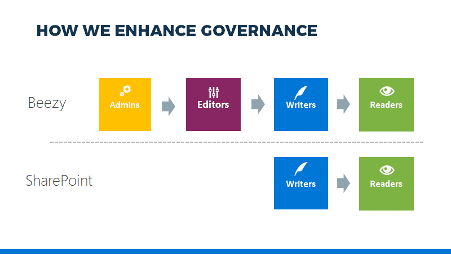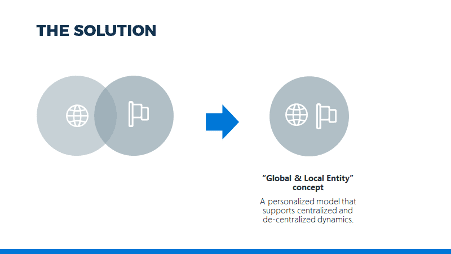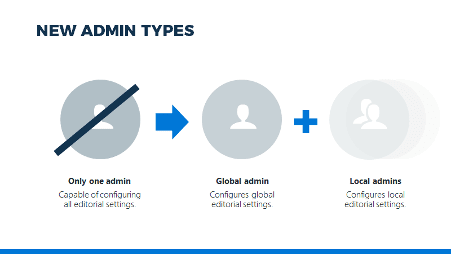Bridging the gaps in SharePoint – insights from Beezy at the DWG Institute Technology Lab
We held a fantastic DWG Technology and Research Institute Technology Lab, an online event hosted from Chicago. Here we brought together practitioners and providers to share insights into accelerating the digital workplace. We were pleased that Beezy, one of the most well-established intranet and digital workplace technology companies, were able to bring along a great team of speakers:
- Maximo Castango, Chief Product Officer, Beezy
- Duncan Smith, Director, Enterprise & Partner Sales, Beezy
- Elisha McCallum, Director of Global Communications, Finning International (a Beezy customer)
The Beezy team led two sessions: the “Illuminate” section focused on sharing expert knowledge and insights gained from experience in the market, while the “Innovation” session discussed future technology trends and innovative approaches with practitioners.
Making SharePoint work in the real world
In the “Illuminate” session, the team from Beezy did a deep dive into using SharePoint and the kind of gaps intranet and digital workplace teams often need to bridge to make a SharePoint intranet or digital workplace work in the real world. Organizations are inherently complex with a variety of different divisions, locations, countries, regions, roles and more, and often this translates into complexity in the ways digital communications are delivered.
It’s true that the devil really is in the detail, and sometimes SharePoint alone needs some configuration or additional work to navigate the challenges of this detail. There are also opportunities for a platform like Beezy to do some of the heavy lifting in terms of making SharePoint work in the real world.

This session started with an exploration of what the Beezy team referred to as “Mind the Gap”: the specific challenges around ensuring that SharePoint works in the way you want it to. This occurs across several different areas:
- Complexity: SharePoint is inherently complex and usually requires both technical know-how and custom work to get it to work properly for communications.
- Push vs pull: central, scalable news management is missing from SharePoint – it is much harder than it might appear to match content metadata with user metadata to underpin content targeting in a way that is truly scalable.
- Social: SharePoint has somewhat siloed social capabilities with comments on news, site content and Yammer all separate, leading to a fragmented approach.
- User experience: at its heart SharePoint is still primarily a desktop experience, with an effective mobile experience lagging behind.
- Governance: the complexity of digital communications, particularly in larger organizations, usually requires more sophisticated governance than SharePoint can handle directly out of the box.
Governance supporting global content targeting

To better illustrate how to navigate these gaps, the team focused on a use case that showed the need for governance to support content targeting to a global audience.
SharePoint tends to put more power in the hands of the content creators, who can control which employee group or audience segment they choose to target their content towards, while there is less power for the readers, who don’t have easy mechanisms for personalizing their news feeds, for example by subscribing to different topics.
The Beezy team explained how they grant more power to readers by adding a governance layer that is controlled by central admins and then a layer of local editors to find the “perfect balance between unique content, specific audiences, and effective delivery”.
This is achieved by allowing intranet admins to set up specific custom audiences (with reference to Active Directory) and then enabling editors (site or channel owners) to connect those audiences to different news channels. This means more effective content targeting is done at the channel level rather than the individual item level, and frees up content authors to focus on producing great content.
Closing the SharePoint gap in action
To emphasize what is possible when you use a product to make SharePoint work better for you, we were lucky to have a quick walk-through of a live demonstration of Finning International’s intranet
Finning International is a dealer and service provider for heavy equipment, and is the world’s largest Caterpillar equipment dealership. Elisha McCallum, the company’s Director of Global Communications, explained how the intranet had helped to break down silos between global locations and operating companies, which had been delivering a fragmented employee experience. The Beezy platform has helped the intranet “Traction” to add more social capabilities, enhanced search, and a better balance between global and regional communication, and between push and pull communications.
Balancing global and local
In the “Innovate” section of the Technology Lab, Max and Duncan also focused on bridging the gap between SharePoint and what organizations actually need, again with a deep dive into a particular scenario.
Balancing global and local content is a familiar issue (and challenge) for internal communicators, intranet teams and digital workplace practitioners. How do you marry the centralization demanded by the global intranet, which usually dictates adherence to standards (content, design, technical, process, etc.) and the inherent decentralization of local intranets that are more tailored to local needs and content? Beezy’s solution is to adopt an approach involving “a personalized model that supports centralized and decentralized dynamics”.

We saw this principle in action in an interesting demo, which differentiated between global intranet administrators (who can set global settings) and local intranet administrators (who can implement local settings within these global parameters). In terms of a SharePoint intranet, these elements extend to the hero area, navigation, stories featured, search, and more. Different teams can have different options, allowing for the balance between central standards and local autonomy that is so often required for a global intranet in practice.

Challenges around delivering global communications
At the end of the “Innovate” session, the group also explored some of the other challenges around the reality of delivering global communications in large, complex companies. Some of the challenges identified included reaching out to remote workers who are working inside manufacturing plants, as well as the cultural challenges associated with delivering content to groups such as contractors and outsourced workers. Again, this emphasizes the importance of being able to tightly manage and deliver meaningful and relevant content and experiences.
Our thanks to Max, Duncan and Elisha for a fascinating session.
Slides from the Tech Lab
Technology Lab June 2020 – Beezy – Illuminate from Digital Workplace Group:
Technology Lab June 2020 – Beezy – Innovate from Digital Workplace Group:
Take the next steps…
Categorised in: → DWG Institute

